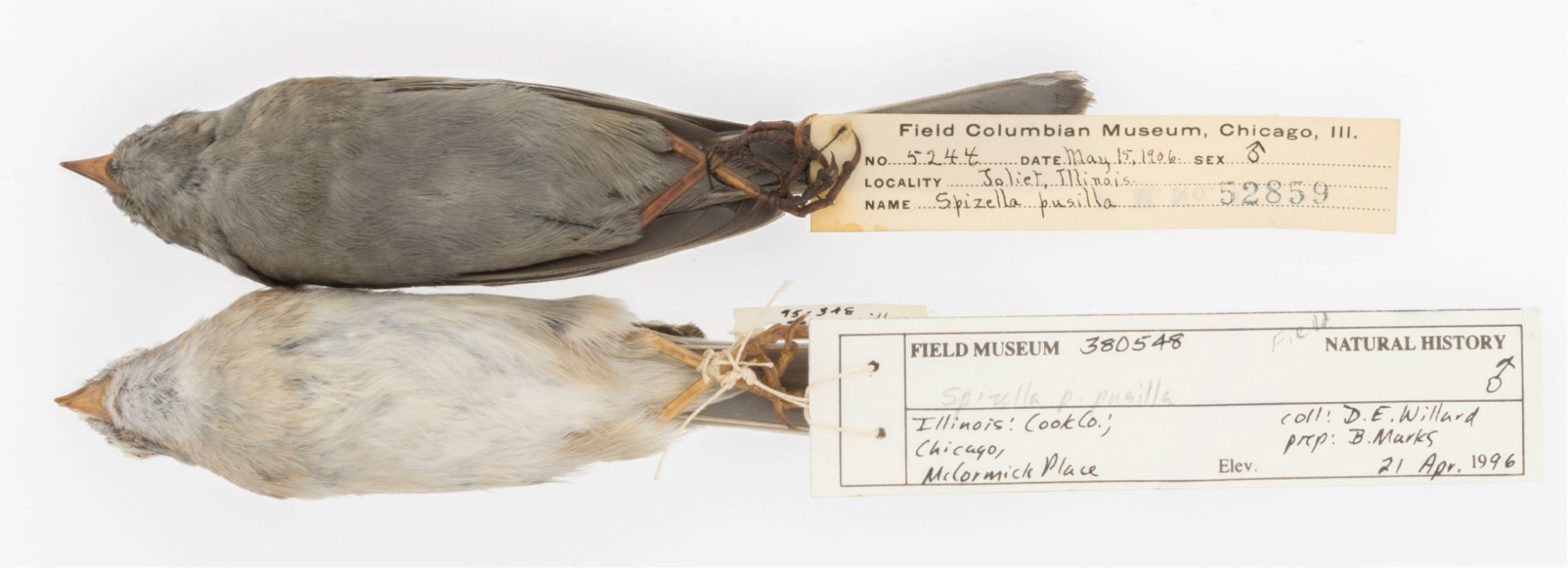

As the male field sparrow soared through the smoke-laden Illinois sky on May 6, 1906, it had no idea that the end was near. It also had no idea that its feathers were collecting scientific data—information that would prove invaluable to researchers more than a century later.
The field sparrow was soon captured, killed, and carefully tagged with the location of its death, the date, and a reference number. It was sent to the Field Museum, where it joined the growing collection of other birds, insects, plants, animals, and artifacts which now numbers 30 million.
Other sparrows, larks, towhees, and woodpeckers joined the field sparrow over the years. Some had endured soot-laden skies during their journeys, and others soared through cleaner air, building up a record of over 1,300 specimens that effectively documented air pollution over the course of 135 years.
When two graduate students at the University of Chicago, one in art history (Carl Fuldner) and one an evolutionary biologist (Shane DuBay) took a closer look at the black, oily residue on the birds’ feathers, they found they were able to document the pervasiveness of coal in society from the late 1800’s through the crash of the Great Depression, a spike in soot as the industrial engine of the country churned through World War II, and a decline in the 1960’s as more regulations came into effect, and power supplies shifted away from distributed steam boilers to more centralized power plants and natural gas.
In the study published in Proceedings of the National Academy of Sciences this week, Fuldner and DuBay’s analysis of the oily soot on the bird feathers showed that the amount of black carbon spewed into the air during the industrial age was higher than other studies, which relied on ice cores and historical records.
“We knew from anecdotal accounts that urban smoke pollution was a serious issue that these cities within the United States industrial belt were tackling,” Fuldner says. “But we didn’t have a quantitative way of looking at the actual nature of the smoke problem over time prior to the mid 20th century, when air monitoring went into effect.”
Without the buildup of birds in a collection—often of the same species collected at different points in history and from different places around the country—the researchers would never have been able to collect this data.
In the paper’s acknowledgments stands a note: “We thank contributors past and present to natural history collections. Projects like this would not be possible without the commitment of individuals to collections,” the authors write.
Natural history collections regularly face funding cuts and are in danger of being dismissed as unnecessary. They tend not to be flashy or in the public view, and often require expensive and dedicated upkeep to maintain aging specimens. But they are vitally important for the research community.
Analysis of eggshells in museum collections earlier in the century eventually connected the decline of bird-of-prey populations to the increase in prevalence of the pesticide DDT. Other samples of birds from the Pacific northwest helped plot the rise of heavy metals like mercury in the environment.
Collections made by previous generations hide scientific discoveries and mysteries just waiting to be uncovered. Amidst the millions of plants and animals carefully packed in boxed drawers and barrels, biologists are still discovering species previously unknown to science—as journalist Ed Yong wrote in The Atlantic last year. “The act of collecting sacrifices a few individual lives, but in return, it gives us irreplaceable information about hidden species and changing communities, about how our wildlife is reacting to our changing world, and about how to protect them in the future,” Yong writes.
Discoveries made in museum collections also have the ability to help protect people, not just wildlife. Tissue samples from mosquitos or, in one case, koalas can contain viruses, helping researchers trace the evolution of deadly pathogens. They can also help identify invasive species before they become a pestilence that threatens agriculture.
And then there are the birds.
The soot collected from the Field Museum’s feathers was also inhaled by our grandparents and great-grandparents, and helped spur local calls to action in municipalities that eventually led to a reduction in the use of soft, bituminous coal for fire. The findings present more evidence for officials to consider as they contemplate bringing forward new regulations on emissions or, as is the case currently, repealing emissions standards.
Fuldner and DuBay hope to continue to study the bird collection, looking deeper into not only the history of the atmosphere across the country, but also what effects the black carbon had on animal health. Many of the specimens’ lungs were pickled, which could provide clues as to how their health fared during those heady, soot-soaked days.
The researchers also hope that their study serves as a reminder to both present and future scholars that there is a wealth of knowledge and discoveries waiting for them in collections like this one, ones that could never have been imagined when they were collected.
“In the early 1900s, there was no way a collector could have known two graduate students in Chicago would use that bird to paint a picture of atmospheric conditions for that time,” DuBay says.
